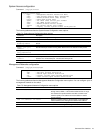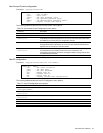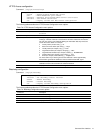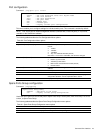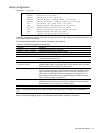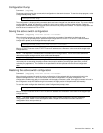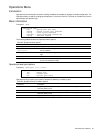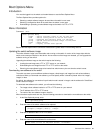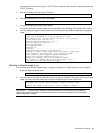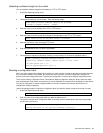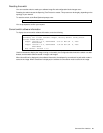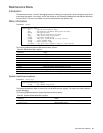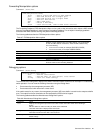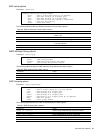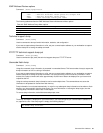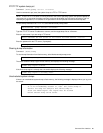
Command Line Interface 87
Forwarding Manipulation options
Command: /maint/fdb
[FDB Manipulation Menu]
find - Show a single FDB entry by MAC address
port - Show FDB entries for a single port
vlan - Show FDB entries for a single VLAN
dump - Show all FDB entries
add - Add a FDB entry
del - Delete a FDB entry
clear - Clear entire FDB, then re-add static entries
The Forwarding Database (FDB) Manipulation Menu can be used to view information and to delete a MAC address
from the Forwarding Database or clear the entire Forwarding Database. This is helpful in identifying problems
associated with MAC address learning and packet forwarding decisions.
The following table describes the FDB Manipulation Menu options.
Table 87 FDB Manipulation Menu options
Command Usage
find <MAC address> [<1-4095>]
Displays a single database entry by its MAC address. You are prompted
to enter the MAC address of the device. Enter the MAC address using
one of the following:
• xx:xx:xx:xx:xx:xx format (for example: 08:00:20:12:34:56)
• xxxxxxxxxxxx format (for example: 080020123456).
port <port number> Displays all FDB entries for a particular port.
vlan <1-4095>
Displays all FDB entries on a single VLAN.
dump Displays all entries in the Forwarding Database.
add Adds a FDB entry.
rem Removes a FDB entry.
clear
Clears the entire Forwarding Database from switch memory, then adds
the static entries to the Forwarding Database.
Debugging options
Command: /maint/debug
[Miscellaneous Debug Menu]
tbuf - Show MP trace buffer
snap - Show MP snap (or post-mortem) trace buffer
clrcfg - Clear all flash configs
The Miscellaneous Debug Menu displays trace buffer information about events that can be helpful in understanding
switch operation. You can view the following information using the Debug Menu:
• Events traced by the management processor (MP)
• Events traced to a buffer area when a reset occurs
If the switch resets for any reason, the management processor (MP) trace buffer is saved into the snap trace buffer
area. The output from these commands can be interpreted by NEC technical support.
The following table describes the Miscellaneous Debug Menu options:
Table 88 Miscellaneous Debug Menu options
Command Usage
tbuf Displays the management processor trace buffer. Header information similar to the following is
shown:
MP trace buffer at 13:28:15 Fri May 25, 2002; mask: 0x2ffdf748
The buffer information is displayed after the header.
snap Displays the management processor snap (or post-mortem) trace buffer. This buffer contains
information traced at the time that a reset occurred.
clrcfg Deletes all flash configuration blocks. The next time the switch is rebooted, it returns to the factory
default settings.



